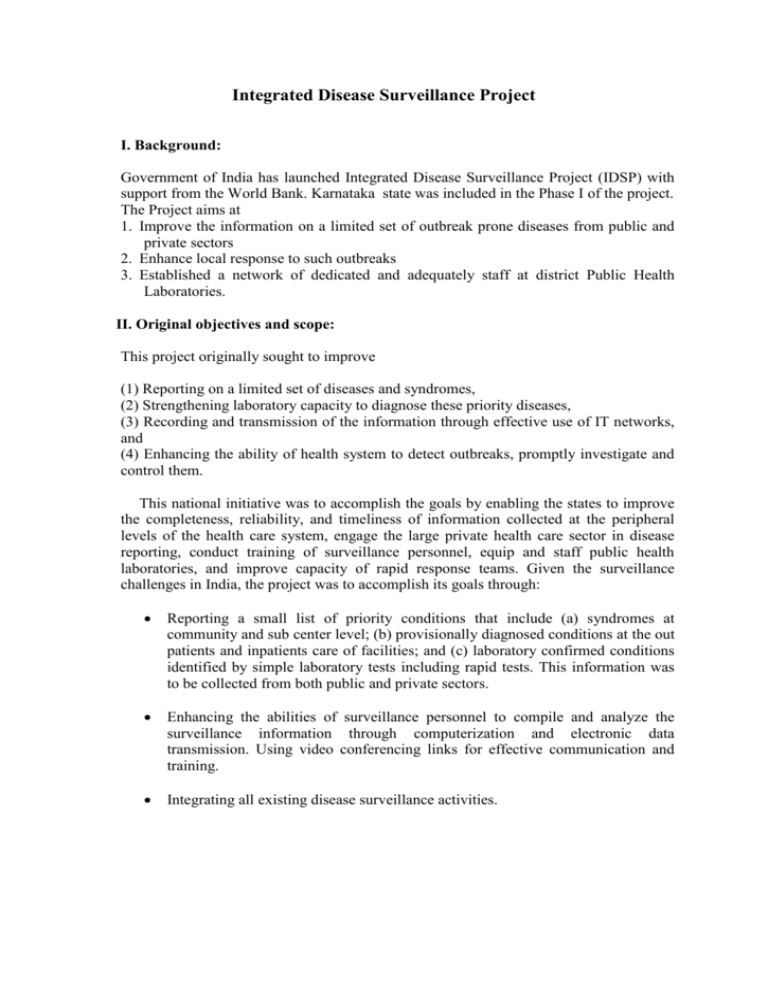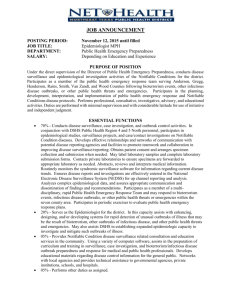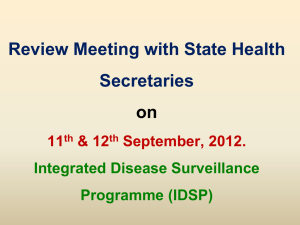IDSP Program information
advertisement

Integrated Disease Surveillance Project I. Background: Government of India has launched Integrated Disease Surveillance Project (IDSP) with support from the World Bank. Karnataka state was included in the Phase I of the project. The Project aims at 1. Improve the information on a limited set of outbreak prone diseases from public and private sectors 2. Enhance local response to such outbreaks 3. Established a network of dedicated and adequately staff at district Public Health Laboratories. II. Original objectives and scope: This project originally sought to improve (1) Reporting on a limited set of diseases and syndromes, (2) Strengthening laboratory capacity to diagnose these priority diseases, (3) Recording and transmission of the information through effective use of IT networks, and (4) Enhancing the ability of health system to detect outbreaks, promptly investigate and control them. This national initiative was to accomplish the goals by enabling the states to improve the completeness, reliability, and timeliness of information collected at the peripheral levels of the health care system, engage the large private health care sector in disease reporting, conduct training of surveillance personnel, equip and staff public health laboratories, and improve capacity of rapid response teams. Given the surveillance challenges in India, the project was to accomplish its goals through: Reporting a small list of priority conditions that include (a) syndromes at community and sub center level; (b) provisionally diagnosed conditions at the out patients and inpatients care of facilities; and (c) laboratory confirmed conditions identified by simple laboratory tests including rapid tests. This information was to be collected from both public and private sectors. Enhancing the abilities of surveillance personnel to compile and analyze the surveillance information through computerization and electronic data transmission. Using video conferencing links for effective communication and training. Integrating all existing disease surveillance activities. III. Successes and Challenges for IDSP in Karnataka A. Successes: Strong political commitment shown at the highest level for improved disease surveillance as a part of the NRHM: Regular oversight by the Commissioner Health and Mission Director NRHM. Additional support to PH laboratories under NRHM. Bi-weekly detailed reviews by the Principal Secretary Health. Network of Public Health Laboratories: Karnataka is one of the few states that have established dedicated public health labs at district level which are headed by a full time medical officer. These labs have approved positions of dedicated Epidemiologists, microbiologists (non-doctor) and entomologists from the state budget. Designating full time district surveillance officers and capacity building: The State has designated the medical officers of the district public health labs as district surveillance officers and ensured that all of them have received 2 weeks competency based training in field epidemiology. These two measures have significantly improved the ability of the DSOs to undertake disease surveillance. Data Analysis and Feedback: The State Surveillance Unit is preparing a weekly surveillance report with graphs and this report is being shared with the senior policy makers as well as districts. Outbreak investigations: The state had improved in reporting outbreaks in 127 in 2009, 167 in 2010,278 in 2011,223 in 2012, 315 in 2013and 283 in 2014 and those were increasingly being confirmed by appropriate laboratory tests. Initiation of media scanning to identify outbreaks reported by media and followup with districts on actions taken. Warning Alerts- By weekly analyzing the trend of the diseases, State is sending warning alerts to Districts. B. Challenges Management of Disease Surveillance: Coordination with City Corporation and other local bodies for disease surveillance has been another problem. Reporting: The data in P forms (provisional diagnosis) being reported by the Primary Health Centers is mostly probable cases Though district and Taluk hospitals, SCs reporting, the information is mostly from the in-patients and also a large part of the data is syndromic, cases as many doctors at these facilities do not write provisional diagnosis in the OPD registers. The state has a large number of medical colleges both in public and private sector. 8 government medical colleges are involved in the IDSP. Outbreak Investigation: Despite improvements in reporting of outbreaks and most of the outbreaks are confirmed. 44 in 2009, 58 in 2010, 103 in 2011, 152 in 2012, 117 in 2013, 187 in 2014 outbreaks are confirmed. Participation of Medical College Pediatrician, Microbiologist, Clinician in outbreak investigation as part of the RRT has been lacking. Analysis and use of data: Mostly limited to district and state levels. Requires more decentralized analysis at PHC level Districts have started entering data on IDSP portal report of facing problems very often. The monitoring of timeliness, completeness and correctness and follow up with concerned reporting unit is done less frequently. IT component: Denominator data of reporting units and their population to be entered by the DSU into the IDSP portal is not yet complete. VC/Interwise, although functional is not yet stabilized and is of poor quality. Access to IDSP portal is poor due to server downtime. IDSP portal use is limited due to inadequate training for Data Managers and Data Entry Operators. Urban Surveillance: Engagement of the Bangalore City Corporation in surveillance activities. Bangalore City Corporation is reporting the SPL data weekly. IV. Evolving Vision for Disease Surveillance in Karnataka: Karnataka will have a high quality and dependable disease surveillance program which is in compliance with the International Health Regulations (IHR-2005). To support this vision, the State has to : Establish a comprehensive surveillance information system covering public and private hospitals. Build capacities to analyze and use surveillance information at all levels to identify communicable disease outbreaks early. Ensure that all outbreaks will have high quality investigation by multi-specialty rapid response teams supported by laboratory confirmation. Laboratory network: (a) Referral Lab Network : 8 Government Medical Colleges have been identified as Referral Laboratories for laboratory confirmation of epidemic prone diseases. To provide all districts access to diagnostic facilities during outbreak situations, the identified 8 Referral labs were linked to 3-4 districts. Rs. 2 lakhs is released for each Medical College on annual basis for procurement of kits, reagent and consumables. And a ceiling of Rs 3 lakhs has been allocated for reimbursing for the tests performed by Referral Laboratories on quarterly basis. Details of Referral Lab and linked districts is as follows: Sl. Name of Referral Lab No. Hassan Institute of Medical 1 Sciences. Shimoga Institute of Medical 2 Sciences. Vijayanagar Institute of Medical 3 Sciences, Bellary 4 Mysore Medical College. Belgaum Institute of Medical 5 Sciences. 6 Bidar Institute of Medical Sciences Karnataka Institute of Medical 7 Sciences, Hubli 8 Bangalore Medical College Districts linked Hassan, Kodagu , Dakshina Kannada Chikmagalur , Shimoga, Davanagere Bellary, Koppal, Raichur Mysore , Mandya, Chamarajnagar Bijapur , Belgaum, Bagalkote Bidar, Gulbarga, Yadgiri Dharwar, Uttara Kannada , Haveri, Gadag Bangalore(R),Bangalore(U),Kolar, Ramanagar,Chikkaballapura, Tumkur. (B) Priority labs: Chitradurga & Udupi District Public Health Laboratory have been strengthened to confirm the outbreaks and diagnosis of epidemic prone diseases and thus enabling immediate focused containment measures. Human resource and equipments reuired for functioning of the lab has been provided by G.O.I. Priority labs are given an annual grant of 4 lakh for purchase of kits, reagents and consumables. (c) Model Laboratories :IDSP has proposed the development of district Hospital labs for Sentinel Surveillance of epidemic prone diseases. The criteria for identifying the district labs are as follows: a) It must be integrated in the existing health system in the district. b) Must have an established system of receiving routine clinical specimens (linked with district hospitals or other mechanisms). c) Be accessible and Provide service needed by the community and those managing health care in the district. As per the approved PIP, GOI has released a budget of Rs 107.40 Lakhs ( @ Rs 17.9lakh / Lab) in FY 2014-15 towards the procurement of Laboratory Equipments to strengthen six District hospital Laboratories of Gadag, Koppal, Gulbarga, Bagalkot, Davangere and Haveri District. These Laboratories would function as District Public Health Laboratory on Model basis in diagnosis of Communicable diseases. The basic equipments that are being procured are Bio safety cabinet, Autoclave (Sterilization), Hot Air Oven, Autoclave for decontamination, Incubators, Binocular microscopes, ELISA reader and washer, Refrigerator, Computer with printer, scanner, UPS, Deep Freezer, Centrifuge, Micro pipette, Water bath, Weighing scale & Mixer and Needle Destroyer. Influenza Surveillance: Karnataka has tackled H1N1 during 2009-10. However, the threats from Influenza outbreaks are always impending. The threat to the community especially with regard to H5N1 is expected to have more mortalities. Hence the State has to be prepared for the eventualities in regard to finances and logistics. Ebola Surveillance: The State Government initiated surveillance and monitoring of Ebola disease with the communication of advisory note from GoI and declaration of Ebola as a Public Health Emergency of International Concern (PHEIC). As per directions from Honourable Minister for Health, Shri U.T Khadar, a meeting was convened on 8-8-2014 under the chairmanship of Director Health and family Welfare Services and involving Surveillance Officers of State, Bangalore urban and rural, Airport Health Officers Bangalore International Airport, Resident doctors of the Infectious Diseases (ED) Hospital to plan the strategies to be initiated for the surveillance and monitoring, screening of passengers from the affected countries and quarantine the suspected patients at Rajeev Gandhi Institute of Chest Diseases, Bangalore. Copy of meeting proceedings is attached (Annexure 1). Brief description of the activities is as below, 1. Human Resources: Three Medical Doctors from State Health Department / Airport have been nominated and deputed for passive screening of passengers from affected countries at Kempegowda International Airport, Bangalore and Mangalore International Airport with immediate effect commencing from 8-8-2014 on 24X7. 2. Deputy Director, State Surveillance Unit is designated as the State Nodal Officer for Ebola Viral Disease. 3. State has taken care of the IEC with regard to Disease symptoms in terms of banners, flexes and pamphlets and promoting self reporting of the suspects to the health facility. The Nodal Officer along with a team of Physician from Manipal Hospital Bangalore and Microbiologist from KIMS Hospital Bangalore have participated in IEC to community through Regional TV9 Media. 4. Logistics:- 108 Ambulance has been arranged to commute the suspected cases to Rajeev Gandhi Chest Disease Hospital from the airport. 5. Reporting:- Daily reporting has been initiated from the APHO and the Bangalore Urban Surveillance Officers regarding the passengers screened and their health status in a prescribed format. 6. Isolation wards:- Designated Isolation ward with 15 beds have been reserved for the suspected patients at Rajiv Gandhi Chest Disease Hospital, Bangalore and Wenlock Hospital Mangalore. 7. All arrangements for collection of clinical samples and transportation to the National Institute of Virology for confirmation are made.. 8. Health Education materials have been displayed at appropriate places including International arrival and waiting area of airport. 9. IDSP unit at Bangalore is keeping a track of all suspected / screened cases and reporting it on daily basis. 10. Till Date 11 suspected cases have been identified from the screening activities amongst which one was Indian National from Tamil Nadu. The State Surveillance Officer Tamil Nadu has been alerted to monitor the case up-to 30 days and has been communicated to report to the concerned GoI authorities. The 6 Nigerian Nationals reported are being monitored for 30 days and the status of the suspected cases is submitted to GoI on daily basis. The remaining 3 Indian are travelled to Ebola affected countries and they are from Shimoga and Gulbarga Districts. The daily health Status report is sent to Delhi. All 10 suspected cases completed the 30days observation period. 11. Training: The following Staffs- (1) State Nodal Officer for Ebola , (2) Physician (RGICD), (3) Microbiologist (State Surveillance Unit), (4) Staff Nurse (RGICD) are trained from Karnataka for the “Training of Master trainers on Preparedness and Response to Ebola Virus Disease(EVD)” at NIHFW New Delhi from 19th to 21st October 2014. GOI has conducted the 2nd round of training on “Training of Rapid Response team on Public Health Preparedness and response to Ebola Virus Disease Outbreak ’’on 3rd to 5th November 2014 at IHM Bangalore. Totally 18 members are trained on Ebola in the State. Their skills and Knowledge will help in containing the outbreak. 12. State have been received the 100 cartoons of Personal Protective Equipment (PPE) form the GOI. PPEs are supplied to RGICD Hospital and to Wenlock Hospital, District Surveillance Unit, Mangalore. 13. State Crisis Management Committee has been formed and first meeting was held on 11 November 2014 under the Chairmanship of Chief Secretary. 14. Technical Advisory Committee has been formed and first meeting was held 18 November 2014 under Chairmanship of Director of Health Services. 15. A team of officers had been inspected the arrangement made for Ebola at Kempegowda International Airport, Bengaluru on 19 Nov 2014.




